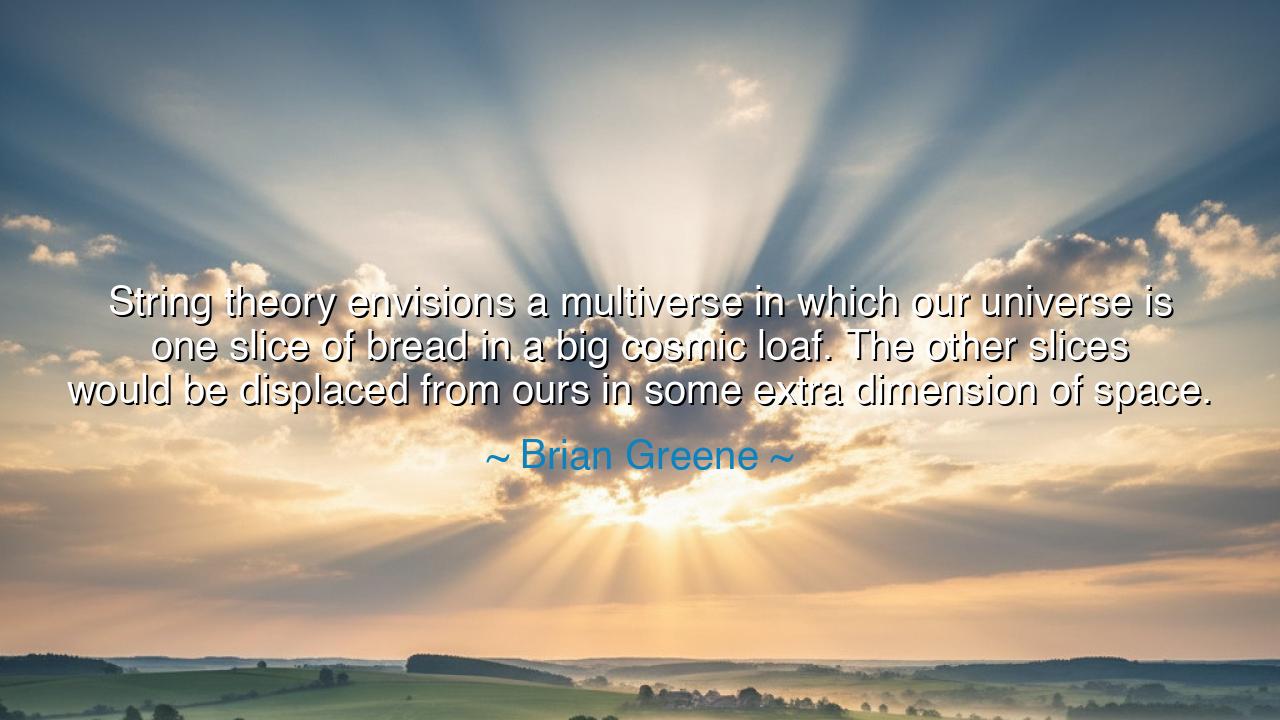
String theory envisions a multiverse in which our universe is one
String theory envisions a multiverse in which our universe is one slice of bread in a big cosmic loaf. The other slices would be displaced from ours in some extra dimension of space.






Hear the voice of Brian Greene, seeker of the hidden fabric of existence, who proclaimed: “String theory envisions a multiverse in which our universe is one slice of bread in a big cosmic loaf. The other slices would be displaced from ours in some extra dimension of space.” Though uttered in the language of science, these words carry the grandeur of myth, the daring of prophecy, and the humility of one who gazes into the infinite. They invite us to imagine that our world, which seems so complete, so all-encompassing, may be but one page in an endless book, one note in an eternal symphony.
The image of the loaf of bread is simple, yet profoundly evocative. Just as a loaf contains many slices, each similar yet separate, so too may the multiverse hold countless worlds, each governed by its own laws, each hidden from the others by unseen folds of reality. Our universe, vast as it seems, may be but a thin layer, surrounded by neighbors we cannot yet touch. What is familiar to us—stars, galaxies, time itself—might be but one form of existence among many. Greene’s metaphor brings the incomprehensible within reach, allowing the mind to grasp infinity through the humble symbol of bread.
The origin of these words lies in the daring framework of string theory, which proposes that the fundamental building blocks of reality are not particles, but vibrating strings of energy, dancing in dimensions beyond the ones we see. In this vision, unseen dimensions cradle universes side by side, layered yet separate, like pages bound in the same book. It is a modern echo of ancient whispers—of Hindu cosmologies that spoke of infinite worlds arising and dissolving, of Norse myths where many realms hung upon Yggdrasil, the world-tree. Science, with new tools, now returns us to the same awe that myth once stirred.
Consider the story of Edwin Hubble, who once looked into the night sky and discovered that the universe itself was expanding, revealing galaxies beyond imagination. Before his work, men believed our Milky Way to be the whole of creation; after, they realized it was but one island among billions. What Hubble did for galaxies, Greene and his fellow explorers attempt for universes: to show us that what we call “all” may be but one portion of a far greater cosmic loaf. Humanity has faced this humbling before, and each time, though pride was shaken, wonder grew.
Greene’s words are not only about physics, but about perspective. They teach us that certainty is fragile, and that reality may be larger, stranger, and richer than our senses can perceive. When we believe we stand at the center, we grow arrogant; when we learn we are but one slice among many, we grow wise. To know that there may be other universes, beyond our sight, is to remember our smallness—but also to feel the sacred weight of being alive in this particular one.
The lesson for us is clear: let us live not with narrow certainty, but with reverent curiosity. If the multiverse exists, then our struggles and joys are one melody among countless others, yet no less meaningful. If it does not, still the metaphor teaches humility—that life is always more mysterious than it first appears. Either way, Greene calls us to lift our eyes from the surface of the bread and contemplate the vast loaf of existence.
Practical action flows from this teaching: embrace the unknown, rather than fearing it. Study, explore, imagine, and do not let the limits of current knowledge bind your vision. In daily life, too, this applies: remember that what you see of others is only one “slice,” and there are always hidden dimensions to their struggles and strengths. Just as the cosmos holds unseen universes, so too does every soul contain worlds invisible to the eye.
Take these words as a torch: our universe may be but one among many, yet it is ours to cherish. Live with awe, seek with courage, and never believe that reality ends at the edge of your vision. For beyond that edge lies mystery, and within mystery lies the endless invitation to wonder.






AAdministratorAdministrator
Welcome, honored guests. Please leave a comment, we will respond soon